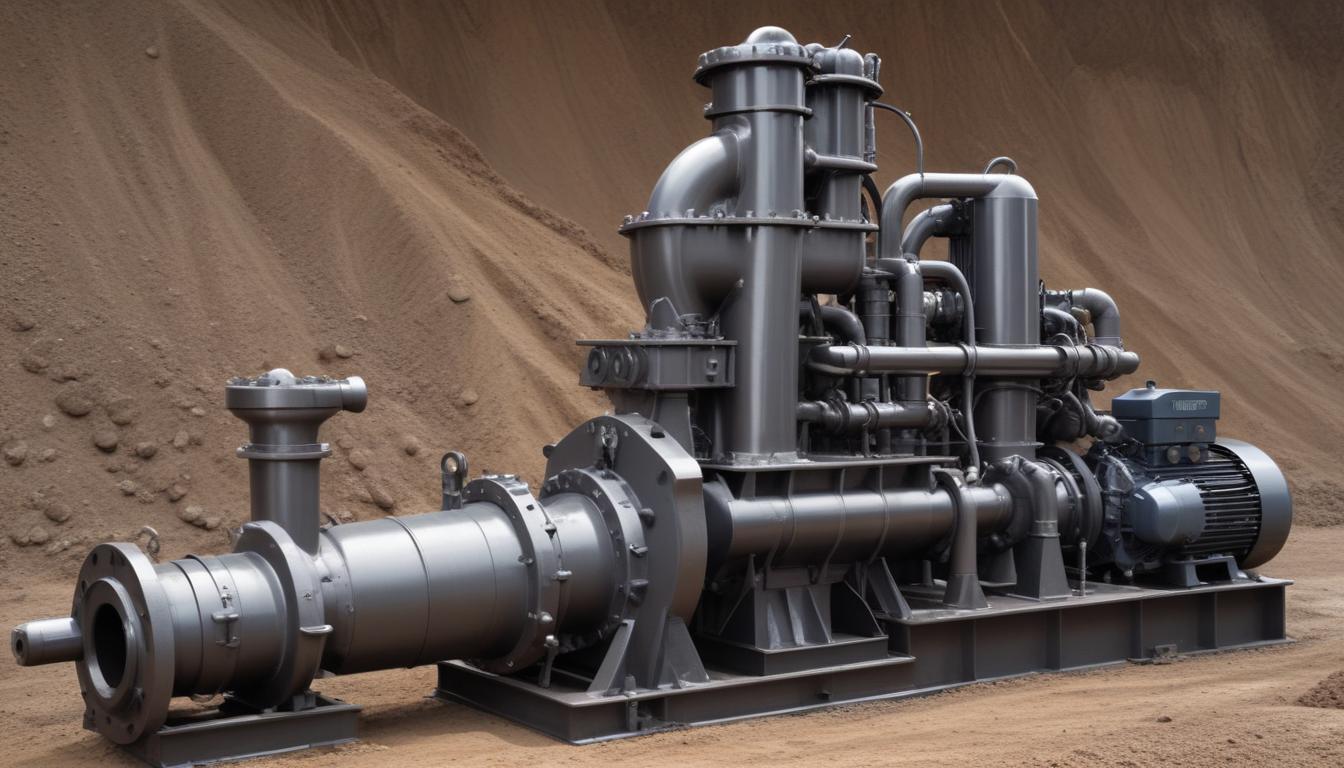pumps used in mining operations
Mining operations rely on a variety of specialized pumps to handle the diverse fluids and materials encountered. Understanding the different types of pumps available is essential for optimizing performance and ensuring the efficiency of mining processes.
- Centrifugal Pumps: These pumps use rotational energy to move fluids and are widely utilized for dewatering, cooling, and circulating water in mining systems. They are favored for their high flow rates and relatively simple maintenance.
- Submersible Pumps: Designed to operate underwater, submersible pumps are ideal for pumping water from deep mines and handling liquids in confined spaces. Their sealed construction prevents contamination and enhances durability in harsh environments.
- Slurry Pumps: Specifically engineered to transport mixtures of water and abrasive solids, slurry pumps are critical in mineral processing where the handling of slurry is common. They feature robust materials and specialized impellers to resist wear and tear.
- Positive Displacement Pumps: These pumps deliver a fixed volume of fluid per cycle and are used in applications requiring precise flow control, such as chemical dosing and hydraulic systems within mining machinery.
- Jet Pumps: Utilizing a combination of velocity and pressure, jet pumps are used for shallow dewatering and are effective in situations where space is limited and suction lift requirements are modest.
| Pump Type | Key Features | Typical Applications |
|---|---|---|
| Centrifugal Pumps | High flow rates, simple design, easy maintenance | Dewatering, cooling systems, water circulation |
| Submersible Pumps | Operation underwater, sealed construction, durable | Deep mine water extraction, confined space liquid handling |
| Slurry Pumps | Resistant to abrasion, specialized impellers | Mineral processing, slurry transportation |
| Positive Displacement Pumps | Precise flow control, fixed volume delivery | Chemical dosing, hydraulic systems |
| Jet Pumps | Combination of velocity and pressure, compact size | Shallow dewatering, limited-space applications |
Selecting the appropriate mining pump type is crucial for addressing the specific challenges presented by different mining environments and operational requirements. Each pump type offers distinct advantages that can significantly enhance the efficiency and reliability of mining operations.
applications of pumps in mining
In mining operations, pumps play a pivotal role in various processes, ensuring the smooth and efficient extraction and processing of minerals. Their applications are diverse, each serving a specific function critical to the overall success of mining activities.
Dewatering is one of the primary applications of pumps in mining. It involves the removal of water from mining sites to maintain dry working conditions and prevent flooding. Effective dewatering is essential for:
- Maintaining Mine Safety: Removing excess water reduces the risk of accidents and collapses.
- Operational Efficiency: Ensures uninterrupted access to mining areas, facilitating continuous extraction processes.
- Equipment Protection: Prevents water-related damage to mining machinery and infrastructure.
Slurry Transport is another critical application, particularly in mineral processing. Slurry pumps are designed to handle mixtures of water and fine particles, enabling the efficient movement of these mixtures from the excavation site to processing facilities. Key aspects include:
- Material Handling: Transports ore slurry to concentrators where valuable minerals are separated.
- Process Circulation: Maintains the flow of slurry through various processing stages, ensuring consistent output.
- Environmental Management: Facilitates the controlled disposal of tailings, minimizing environmental impact.
Cooling Systems within mining operations rely heavily on pumps to regulate temperatures. Effective cooling is vital for:
- Machinery Operation: Prevents overheating of equipment such as drills, conveyors, and processing units.
- Worker Comfort: Enhances the working environment by maintaining cooler temperatures in underground and surface facilities.
- Process Stability: Ensures that temperature-sensitive processes remain within optimal ranges.
Chemical Injection systems in mining require precise dosing of chemicals used in leaching and flotation processes. Positive displacement pumps are typically employed for this application due to their ability to deliver accurate and consistent flow rates. This ensures:
- Process Accuracy: Maintains the correct chemical concentrations necessary for effective mineral extraction.
- Operational Control: Allows for fine-tuning of chemical inputs based on real-time process feedback.
- Safety Compliance: Minimizes the risk of over- or under-dosing, ensuring safe handling of hazardous chemicals.
Ventilation Systems in underground mines depend on pumps to circulate air, ensuring adequate ventilation for workers and machinery. Essential functions include:
- Air Quality Maintenance: Removes harmful gases and replenishes oxygen levels.
- Temperature Regulation: Helps control the temperature within mining shafts and tunnels.
- Dust Control: Assists in minimizing airborne dust particles, enhancing visibility and reducing respiratory hazards.
Water Supply systems also utilize pumps to provide the necessary water for various mining operations. This includes:
- Drilling Operations: Supplies water for cooling drill bits and transporting drill cuttings to the surface.
- Hydraulic Systems: Powers hydraulic machinery used in extraction and material handling.
- Processing Plants: Provides water needed for mineral processing activities, such as flotation and leaching.
The integration of these pump applications ensures that mining operations run smoothly, safely, and efficiently. By addressing the specific needs of each process, mining pumps contribute significantly to the overall productivity and sustainability of mining projects.
pump selection criteria
Selecting the right pump for mining operations involves careful consideration of various factors to ensure optimal performance and longevity. The following criteria are essential in making an informed decision:
- Flow Rate and Head Requirements: Determine the required flow rate (volume of fluid per unit time) and the head (pressure) the pump must achieve. This ensures the pump can handle the necessary volume and overcome the resistance within the system.
- Fluid Characteristics: Analyze the properties of the fluid to be pumped, including viscosity, temperature, and the presence of solids or abrasives. For instance, slurry pumps are necessary for handling abrasive mixtures, while submersible pumps are ideal for viscous or contaminated fluids.
- Environmental Conditions: Consider the operating environment, such as underground or surface conditions, potential exposure to corrosive substances, and ambient temperature. Pumps with appropriate sealing and corrosion-resistant materials should be selected to withstand harsh environments.
- Energy Efficiency: Evaluate the pump’s energy consumption relative to its performance. Energy-efficient pumps reduce operational costs and minimize the environmental impact, making them a sustainable choice for long-term operations.
- Durability and Maintenance: Prioritize pumps constructed from robust materials that can withstand the rigors of mining operations. Additionally, ease of maintenance and the availability of spare parts are crucial for minimizing downtime and ensuring continuous operation.
- Cost Considerations: Balance the initial purchase price with the total cost of ownership, including installation, maintenance, and energy costs. Selecting a pump that offers reliability and efficiency can lead to significant savings over its lifespan.
- Compliance with Standards and Regulations: Ensure that the selected pump meets all relevant industry standards and regulatory requirements, particularly those related to safety and environmental protection.
- Compatibility with Existing Systems: Assess how the new pump will integrate with existing infrastructure and control systems. Compatibility ensures seamless operation and reduces the need for extensive modifications.
- Manufacturer Support and Warranty: Choose pumps from reputable manufacturers that offer comprehensive support, warranties, and technical assistance. Reliable support can enhance the pump’s performance and address any issues promptly.
| Selection Criteria | Description | Importance |
|---|---|---|
| Flow Rate and Head | Ensures the pump can handle the required volume and pressure. | Critical for meeting operational demands. |
| Fluid Characteristics | Determines the suitability of the pump for specific types of fluids. | Prevents pump failure and extends lifespan. |
| Environmental Conditions | Matches the pump’s durability to the operating environment. | Enhances reliability and reduces maintenance needs. |
| Energy Efficiency | Minimizes energy consumption and operational costs. | Promotes cost-effectiveness and sustainability. |
| Durability and Maintenance | Ensures the pump can withstand operational stresses and is easy to service. | Reduces downtime and maintenance expenses. |
| Cost Considerations | Balances initial and ongoing costs for overall economic viability. | Ensures financial sustainability of operations. |
| Compliance | Meets industry and regulatory standards for safety and environmental impact. | Ensures legal compliance and operational legitimacy. |
| Compatibility | Integrates seamlessly with existing systems and infrastructure. | Facilitates smooth implementation and operation. |
| Manufacturer Support | Provides access to technical support, warranties, and parts. | Enhances pump performance and reliability. |
By meticulously evaluating these selection criteria, mining operations can choose the most suitable pumps that not only meet their specific requirements but also contribute to the overall efficiency and sustainability of their processes. Proper pump selection is a fundamental step in ensuring the success and longevity of mining projects.
maintenance and troubleshooting
 Regular maintenance and effective troubleshooting of mining pumps are crucial to ensure their reliable operation and to extend their lifespan. Adhering to a comprehensive maintenance schedule not only prevents unexpected downtimes but also enhances overall pump performance, which is vital in the demanding conditions of mining operations.
Regular maintenance and effective troubleshooting of mining pumps are crucial to ensure their reliable operation and to extend their lifespan. Adhering to a comprehensive maintenance schedule not only prevents unexpected downtimes but also enhances overall pump performance, which is vital in the demanding conditions of mining operations.
Preventative Maintenance involves proactive measures to address potential issues before they escalate. Key aspects include:
- Scheduled Inspections: Conduct routine inspections to identify signs of wear, corrosion, or damage. Focus areas include seals, bearings, impellers, and casing integrity.
- Lubrication: Regularly lubricate all moving parts as per the manufacturer’s recommendations to minimize friction and prevent overheating. Proper lubrication is essential for maintaining smooth pump operation.
- Cleaning: Keep pumps and their surrounding areas free from debris and contaminants. This is particularly important for slurry and submersible pumps, where buildup can impede performance.
- Component Replacement: Proactively replace worn or damaged parts such as seals, gaskets, and impellers. Using high-quality replacement components ensures continued pump efficiency and reliability.
Common Issues encountered with mining pumps and their solutions are outlined below:
| Issue | Possible Causes | Solutions |
|---|---|---|
| Leaks | Worn seals, gasket failures, or improper installation | Replace faulty seals or gaskets and ensure correct installation procedures are followed. |
| Reduced Flow Rate | Clogged impellers, pipe obstructions, or worn parts | Clean or replace impellers, clear pipe blockages, and replace any worn components. |
| Overheating | Insufficient lubrication, blocked cooling systems, or excessive load | Ensure proper lubrication, clean cooling passages, and verify that the pump is operating within its specified load parameters. |
| Unusual Noises | Misalignment, bearing wear, or cavitation | Realign pump and motor, inspect and replace bearings, and address cavitation by adjusting pump operation parameters. |
Troubleshooting Steps for mining pumps typically involve a systematic approach:
- Identify the Symptom: Determine the specific issue, such as a leak, noise, or performance drop.
- Assess the Cause: Investigate potential causes using visual inspections and diagnostic tools.
- Develop a Solution: Based on the identified cause, plan the necessary repairs or adjustments.
- Implement the Fix: Execute the planned maintenance or repairs, ensuring all safety protocols are followed.
- Test and Validate: After repairs, test the pump to ensure the issue has been resolved and monitor its performance.
Maintenance Best Practices for mining pumps include:
- Documentation: Keep detailed records of all maintenance activities, inspections, and repairs to track pump performance and identify recurring issues.
- Training: Ensure that personnel are properly trained in pump maintenance and troubleshooting techniques to enhance efficiency and safety.
- Spare Parts Inventory: Maintain an inventory of critical spare parts to minimize downtime during repairs and replacements.
- Performance Monitoring: Utilize monitoring systems to continuously track pump performance metrics, allowing for early detection of potential problems.
Implementing a thorough maintenance and troubleshooting strategy for mining pumps is essential for minimizing operational disruptions and maximizing pump efficiency. By adhering to these practices, mining operations can ensure the longevity and reliability of their pumping systems, thereby supporting sustained and efficient mining activities.
safety considerations in pump operations
Ensuring the safety of personnel and equipment in mining pump operations is paramount. The hazardous environments typical of mining sites necessitate rigorous safety protocols to prevent accidents and maintain uninterrupted operations.
Hazard Identification is the first step in creating a safe working environment. Common hazards associated with pump operations include:
- Electrical Risks: Exposure to electrical components and potential for short circuits or electrical fires.
- Mechanical Failures: Risk of injury from moving parts, such as impellers and belts.
- Chemical Exposure: Handling of hazardous chemicals used in processes like chemical injection.
- Environmental Hazards: Potential for flooding, dust generation, and exposure to toxic gases.
- Ergonomic Risks: Strains from manual handling of heavy pump components and repetitive motions.
To mitigate these hazards, the following safety measures should be implemented:
- Proper Training and Certification: Ensure that all operators are adequately trained and certified in pump operation and safety procedures. Regular training updates should be provided to keep up with evolving safety standards and technologies.
- Lockout/Tagout (LOTO) Procedures: Implement LOTO protocols to ensure that pumps are properly shut down and cannot be accidentally started during maintenance or repair work. This prevents accidental energization and potential injuries.
- Personal Protective Equipment (PPE): Mandate the use of appropriate PPE, including gloves, safety goggles, helmets, and protective footwear, to safeguard workers from potential hazards.
- Regular Inspections and Maintenance: Conduct routine inspections to identify and rectify potential safety issues before they result in accidents. Maintenance should be performed according to the manufacturer’s guidelines and industry best practices.
- Emergency Response Plans: Develop and communicate clear emergency procedures for scenarios such as chemical spills, pump failures, and electrical fires. Regular drills should be conducted to ensure readiness.
- Proper Ventilation: Ensure adequate ventilation in areas where pumps operate to prevent the accumulation of toxic gases and maintain air quality.
- Safe Work Practices: Establish and enforce safe work practices, such as proper lifting techniques, to reduce the risk of ergonomic injuries and accidents.
Safety Standards and Compliance play a crucial role in maintaining safe pump operations. Adherence to industry standards such as those set by the Occupational Safety and Health Administration (OSHA) and the Mine Safety and Health Administration (MSHA) is essential. Compliance ensures that mining operations meet the required safety benchmarks and reduce the likelihood of regulatory violations.
| Safety Aspect | Best Practices | Benefits |
|---|---|---|
| Electrical Safety | Install proper grounding, use insulated tools, and conduct regular electrical system inspections. | Prevents electrical shocks, fires, and equipment damage. |
| Mechanical Safety | Use guards and shields on moving parts, ensure proper alignment of components, and secure loose items. | Reduces risk of physical injuries and mechanical failures. |
| Chemical Safety | Store chemicals properly, use containment measures, and provide adequate ventilation. | Minimizes exposure to hazardous substances and environmental contamination. |
| Ergonomic Safety | Provide ergonomic tools, implement job rotation, and design workstations to reduce strain. | Decreases the incidence of musculoskeletal disorders and enhances worker comfort. |
| Emergency Preparedness | Develop clear emergency protocols, maintain accessible emergency equipment, and train staff regularly. | Ensures quick and effective response to emergencies, reducing potential harm. |
Risk Assessment is an ongoing process that involves identifying potential hazards, evaluating the risks associated with them, and implementing control measures to mitigate these risks. Regular risk assessments help in adapting to new challenges and maintaining a high standard of safety in pump operations.
Incident Reporting and Investigation are critical components of a robust safety program. Encouraging transparent reporting of near-misses and incidents allows for timely investigations, identification of root causes, and implementation of corrective actions to prevent recurrence.
Safety Culture within the organization fosters an environment where safety is prioritized and every team member is responsible for maintaining it. Promoting open communication, recognizing safe behaviors, and involving employees in safety planning contribute to a strong safety culture.
Implementing comprehensive safety considerations in pump operations not only protects workers and equipment but also enhances the overall efficiency and reliability of mining operations. By prioritizing safety, mining projects can achieve sustainable and productive outcomes while minimizing risks and ensuring compliance with regulatory standards.




